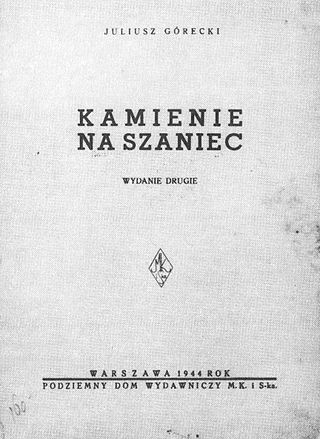
National Armed Forces was a Polish right-wing underground military organization of the National Democracy operating from 1942. During World War II, NSZ troops fought against Nazi Germany and communist partisans. There were also cases of fights with the Home Army.

In July 1941, 25 Polish academics from the city of Lwów along with the 25 of their family members were killed by Nazi German occupation forces. By targeting prominent citizens and intellectuals for elimination, the Nazis hoped to prevent anti-Nazi activity and to weaken the resolve of the Polish resistance movement. According to an eyewitness the executions were carried out by an Einsatzgruppe unit under the command of Karl Eberhard Schöngarth with the participation of Ukrainian translators in German uniforms.

Kedyw (Polish pronunciation:[ˈkɛdɨf], partial acronym of Kierownictwo Dywersji was a Polish World War II Home Army unit that conducted active and passive sabotage, propaganda and armed operations against Nazi German forces and collaborators.

The kotwica was an emblem of the Polish Underground State and Armia Krajowa used during World War II. It was created in 1942 by members of the Wawer minor sabotage unit within the AK, as an easily usable emblem for the struggle to regain the country's independence. The initial meaning of the initialism PW was pomścimy Wawer, in reference to the 1939 Wawer massacre, which was considered to be one of the first large scale massacres of Polish civilians by German troops in occupied Poland.

"Grey Ranks" was a codename for the underground paramilitary Polish Scouting Association during World War II.

Maciej Aleksy Dawidowski codename: Alek, Glizda, Kopernicki, Koziorożec was a Polish scoutmaster (podharcmistrz), Polish Scouting resistance activist and Second Lieutenant of the Armia Krajowa during the Second World War. Dawidowski is a main character in the books Kamienie na Szaniec by Aleksander Kamiński, and Rudy, Alek, Zośka by Barbara Wachowicz.

Stanisław Broniewski alias Stefan Orsza, Witold, K. Krzemień was a Polish economist, Chief Scouts of the Gray Ranks and Second lieutenant of the Home Army during the World War II.

Jan Roman Bytnar, nom de guerre "Rudy" (Ginger) was a Polish scoutmaster, a member of Polish scouting anti-Nazi resistance, and a lieutenant in the Home Army during the Second World War.

Tadeusz Leon Józef Zawadzki was a Polish scout instructor, scoutmaster, Home Army second lieutenant, commander of assault groups in Warsaw, one of the protagonists of Aleksander Kamiński's book Kamienie na szaniec.

Jan Rodowicz, alias "Anoda", was a Polish scout, soldier of the Grey Ranks, the Home Army and of the Armed Forces' Delegation, lieutenant.

Sławomir Maciej Bittner was a Polish scoutmaster (podharcmistrz) and second lieutenant of the Armia Krajowa.

In Poland, the resistance movement during World War II was led by the Home Army. The Polish resistance is notable among others for disrupting German supply lines to the Eastern Front, and providing intelligence reports to the British intelligence agencies. It was a part of the Polish Underground State.

The Royal Arsenal is a building of a military arsenal in the Muranów neighbourhood of the borough of Śródmieście in Warsaw, Poland. It is located at Długa Street, in the proximity of Warsaw's Old Town. Throughout the ages, the building served a variety of roles. It was the scene of heavy fighting during the Warsaw Insurrection of 1794. Currently, it houses the National Museum of Archaeology.

Jan Mazurkiewicz, pseudonym: "Zagłoba", "Socha", "Sęp", "Radosław" was a Polish military leader and politician, colonel of Home Army and brigadier general of the Polish People's Army. Founder of the Secret Military Organization, commander of Kedyw and the Radosław Group during Warsaw Uprising. After the war, he was a political prisoner of the Stalinist period. From 1964 he was vice-president of Society of Fighters for Freedom and Democracy.
Operation Heads was the code name for a series of assassinations of Nazi officials by the World War II Polish Resistance. Those targeted for assassination had been sentenced to death by Polish Underground Special Courts for crimes against Polish citizens during the World War II German occupation of Poland. The operation's code name, literally "Operation Little Heads", was a sardonic reference to the Totenkopf insignia on Nazi German SS uniforms and headgear.

Akcja pod Arsenałem is a Polish historical film, based on the novel Kamienie na szaniec by Aleksander Kamiński, released in 1978 and directed by Jan Łomnicki. Set during World War II, it tells the story of the Operation Arsenal, in which boy scouts of the Grey Ranks freed a truck carrying prisoners, among whom was Jan Bytnar.

Kamienie na szaniec is a 1943 non-fiction novel by Polish writer Aleksander Kamiński. Published by the Polish underground press during the World War II occupation of Poland, the book describes the history of the Polish underground scout movement, the Grey Ranks (and the affiliation, in particular with the Polish Underground State and Home Army, of whom Kamiński was one of the instructors and leaders, from his experiences and several members in particular, from the time before through the occupation until the publication.

The Palmiry massacre was a series of mass executions carried out by Nazi German forces, during World War II, near the village of Palmiry in the Kampinos Forest northwest of Warsaw.

Anna Smoleńska, pseudonym Hania, was a Polish student of art history at the University of Warsaw, author of the symbol of Fighting Poland during World War II and girl scout of the Gray Ranks.

Jan Kryst was a Polish scout and a member of the Polish anti-Nazi resistance. He fought for the Home Army and volunteered for a revenge attack at the Café Adria where he fatally shot several members of the Gestapo before being killed himself.



















